CERTIFICATE IN E-COMMERCE MANAGEMENT LEVEL 3: Unit 1 Basics
VerifiedAdded on 2020/11/30
|11
|2619
|109
Homework Assignment
AI Summary
This assignment provides a comprehensive introduction to e-commerce, exploring the fundamental concepts of e-commerce and m-commerce. It defines key terms, such as bandwidth, channels, and e-business, and outlines the six major e-commerce models: B2B, B2C, C2C, social e-commerce, mobile e-commerce, and location-based e-commerce. The document also delves into the history of e-commerce, highlighting its evolution and growth, and discusses the reasons why customers buy online. Furthermore, it provides guidance on developing an e-commerce business plan, including company description, revenue models, product/service descriptions, and competitive analysis. The assignment emphasizes the importance of building customer relationships and adapting to the changing e-commerce landscape to achieve business goals.
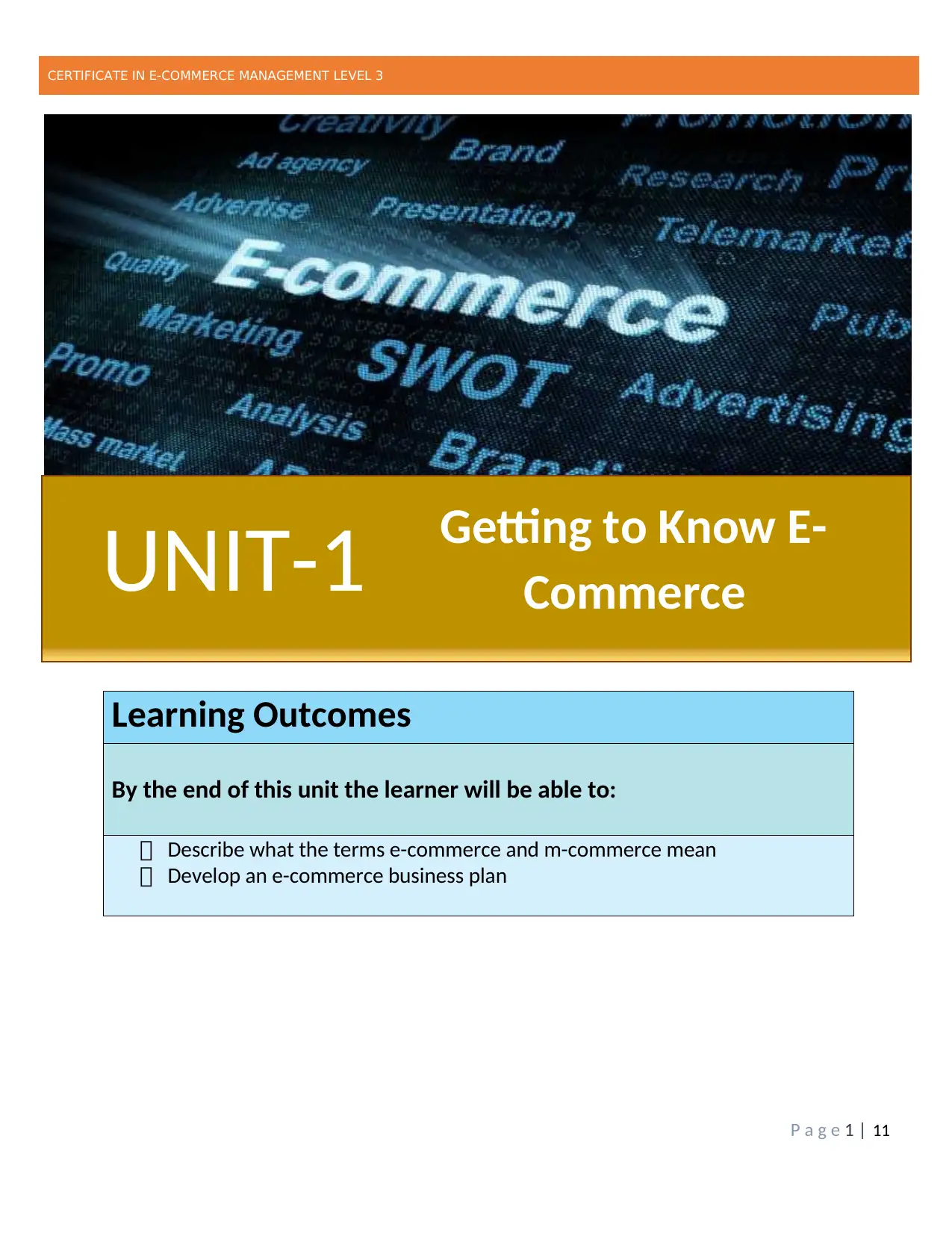
CERTIFICATE IN E-COMMERCE MANAGEMENT LEVEL 3
P a g e 1 | 11
3
Learning Outcomes
By the end of this unit the learner will be able to:
Describe what the terms e-commerce and m-commerce mean
Develop an e-commerce business plan
UNIT-1 Getting to Know E-
Commerce
P a g e 1 | 11
3
Learning Outcomes
By the end of this unit the learner will be able to:
Describe what the terms e-commerce and m-commerce mean
Develop an e-commerce business plan
UNIT-1 Getting to Know E-
Commerce
Paraphrase This Document
Need a fresh take? Get an instant paraphrase of this document with our AI Paraphraser
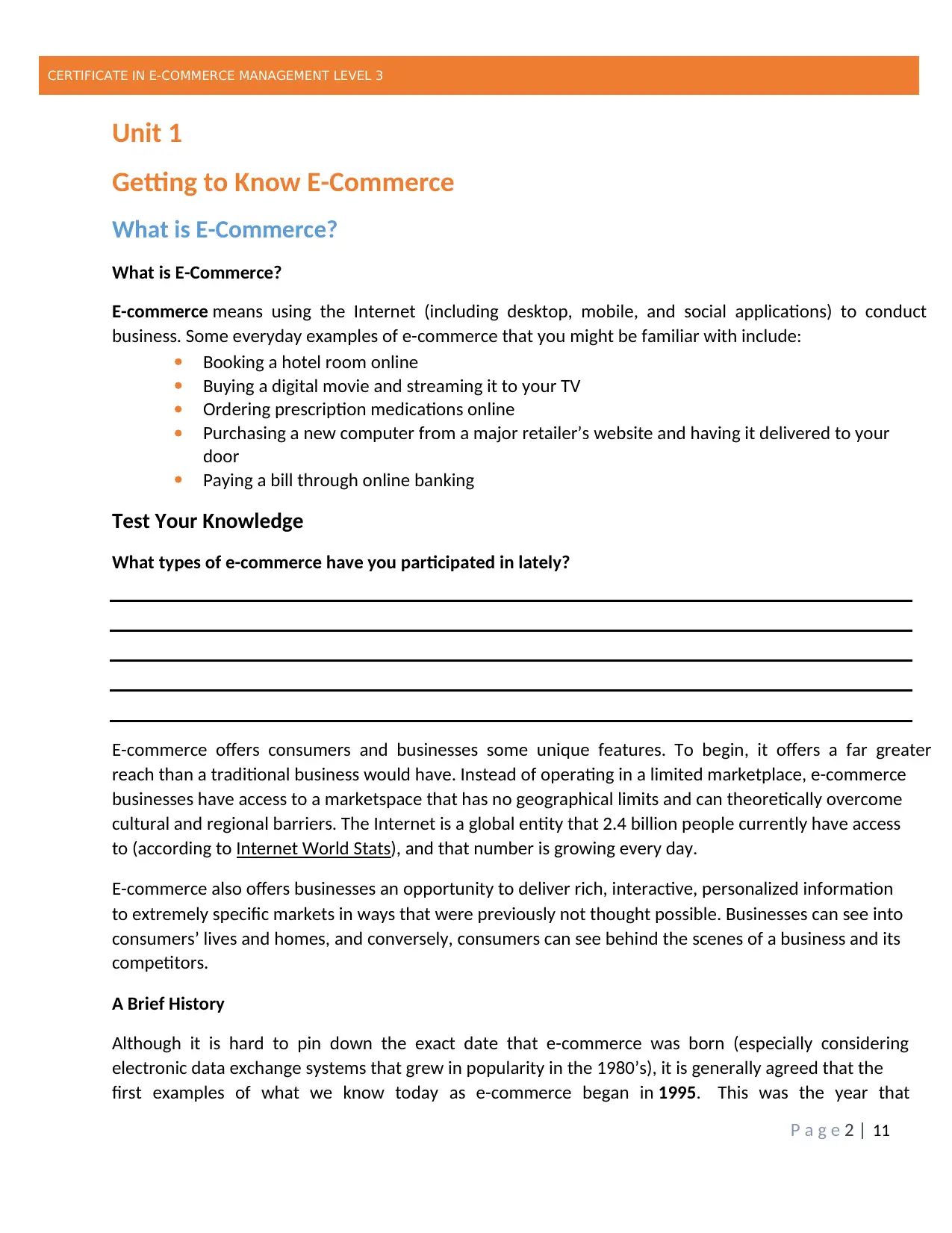
CERTIFICATE IN E-COMMERCE MANAGEMENT LEVEL 3
P a g e 2 | 11
Unit 1
Getting to Know E-Commerce
What is E-Commerce?
What is E-Commerce?
E-commerce means using the Internet (including desktop, mobile, and social applications) to conduct
business. Some everyday examples of e-commerce that you might be familiar with include:
Booking a hotel room online
Buying a digital movie and streaming it to your TV
Ordering prescription medications online
Purchasing a new computer from a major retailer’s website and having it delivered to your
door
Paying a bill through online banking
Test Your Knowledge
What types of e-commerce have you participated in lately?
E-commerce offers consumers and businesses some unique features. To begin, it offers a far greater
reach than a traditional business would have. Instead of operating in a limited marketplace, e-commerce
businesses have access to a marketspace that has no geographical limits and can theoretically overcome
cultural and regional barriers. The Internet is a global entity that 2.4 billion people currently have access
to (according to Internet World Stats), and that number is growing every day.
E-commerce also offers businesses an opportunity to deliver rich, interactive, personalized information
to extremely specific markets in ways that were previously not thought possible. Businesses can see into
consumers’ lives and homes, and conversely, consumers can see behind the scenes of a business and its
competitors.
A Brief History
Although it is hard to pin down the exact date that e-commerce was born (especially considering
electronic data exchange systems that grew in popularity in the 1980’s), it is generally agreed that the
first examples of what we know today as e-commerce began in 1995. This was the year that
P a g e 2 | 11
Unit 1
Getting to Know E-Commerce
What is E-Commerce?
What is E-Commerce?
E-commerce means using the Internet (including desktop, mobile, and social applications) to conduct
business. Some everyday examples of e-commerce that you might be familiar with include:
Booking a hotel room online
Buying a digital movie and streaming it to your TV
Ordering prescription medications online
Purchasing a new computer from a major retailer’s website and having it delivered to your
door
Paying a bill through online banking
Test Your Knowledge
What types of e-commerce have you participated in lately?
E-commerce offers consumers and businesses some unique features. To begin, it offers a far greater
reach than a traditional business would have. Instead of operating in a limited marketplace, e-commerce
businesses have access to a marketspace that has no geographical limits and can theoretically overcome
cultural and regional barriers. The Internet is a global entity that 2.4 billion people currently have access
to (according to Internet World Stats), and that number is growing every day.
E-commerce also offers businesses an opportunity to deliver rich, interactive, personalized information
to extremely specific markets in ways that were previously not thought possible. Businesses can see into
consumers’ lives and homes, and conversely, consumers can see behind the scenes of a business and its
competitors.
A Brief History
Although it is hard to pin down the exact date that e-commerce was born (especially considering
electronic data exchange systems that grew in popularity in the 1980’s), it is generally agreed that the
first examples of what we know today as e-commerce began in 1995. This was the year that
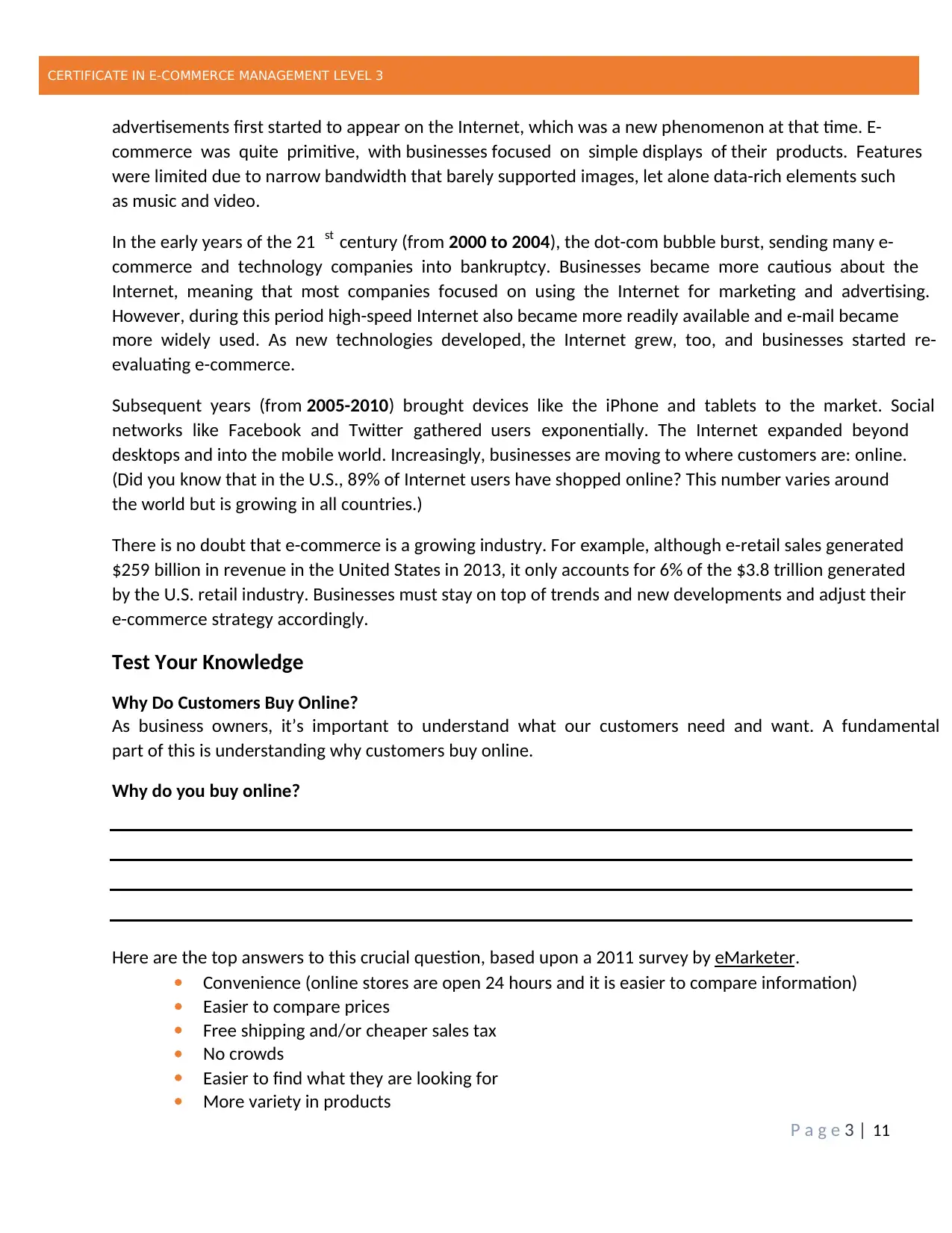
CERTIFICATE IN E-COMMERCE MANAGEMENT LEVEL 3
P a g e 3 | 11
advertisements first started to appear on the Internet, which was a new phenomenon at that time. E-
commerce was quite primitive, with businesses focused on simple displays of their products. Features
were limited due to narrow bandwidth that barely supported images, let alone data-rich elements such
as music and video.
In the early years of the 21 st century (from 2000 to 2004), the dot-com bubble burst, sending many e-
commerce and technology companies into bankruptcy. Businesses became more cautious about the
Internet, meaning that most companies focused on using the Internet for marketing and advertising.
However, during this period high-speed Internet also became more readily available and e-mail became
more widely used. As new technologies developed, the Internet grew, too, and businesses started re-
evaluating e-commerce.
Subsequent years (from 2005-2010) brought devices like the iPhone and tablets to the market. Social
networks like Facebook and Twitter gathered users exponentially. The Internet expanded beyond
desktops and into the mobile world. Increasingly, businesses are moving to where customers are: online.
(Did you know that in the U.S., 89% of Internet users have shopped online? This number varies around
the world but is growing in all countries.)
There is no doubt that e-commerce is a growing industry. For example, although e-retail sales generated
$259 billion in revenue in the United States in 2013, it only accounts for 6% of the $3.8 trillion generated
by the U.S. retail industry. Businesses must stay on top of trends and new developments and adjust their
e-commerce strategy accordingly.
Test Your Knowledge
Why Do Customers Buy Online?
As business owners, it’s important to understand what our customers need and want. A fundamental
part of this is understanding why customers buy online.
Why do you buy online?
Here are the top answers to this crucial question, based upon a 2011 survey by eMarketer.
Convenience (online stores are open 24 hours and it is easier to compare information)
Easier to compare prices
Free shipping and/or cheaper sales tax
No crowds
Easier to find what they are looking for
More variety in products
P a g e 3 | 11
advertisements first started to appear on the Internet, which was a new phenomenon at that time. E-
commerce was quite primitive, with businesses focused on simple displays of their products. Features
were limited due to narrow bandwidth that barely supported images, let alone data-rich elements such
as music and video.
In the early years of the 21 st century (from 2000 to 2004), the dot-com bubble burst, sending many e-
commerce and technology companies into bankruptcy. Businesses became more cautious about the
Internet, meaning that most companies focused on using the Internet for marketing and advertising.
However, during this period high-speed Internet also became more readily available and e-mail became
more widely used. As new technologies developed, the Internet grew, too, and businesses started re-
evaluating e-commerce.
Subsequent years (from 2005-2010) brought devices like the iPhone and tablets to the market. Social
networks like Facebook and Twitter gathered users exponentially. The Internet expanded beyond
desktops and into the mobile world. Increasingly, businesses are moving to where customers are: online.
(Did you know that in the U.S., 89% of Internet users have shopped online? This number varies around
the world but is growing in all countries.)
There is no doubt that e-commerce is a growing industry. For example, although e-retail sales generated
$259 billion in revenue in the United States in 2013, it only accounts for 6% of the $3.8 trillion generated
by the U.S. retail industry. Businesses must stay on top of trends and new developments and adjust their
e-commerce strategy accordingly.
Test Your Knowledge
Why Do Customers Buy Online?
As business owners, it’s important to understand what our customers need and want. A fundamental
part of this is understanding why customers buy online.
Why do you buy online?
Here are the top answers to this crucial question, based upon a 2011 survey by eMarketer.
Convenience (online stores are open 24 hours and it is easier to compare information)
Easier to compare prices
Free shipping and/or cheaper sales tax
No crowds
Easier to find what they are looking for
More variety in products
⊘ This is a preview!⊘
Do you want full access?
Subscribe today to unlock all pages.

Trusted by 1+ million students worldwide
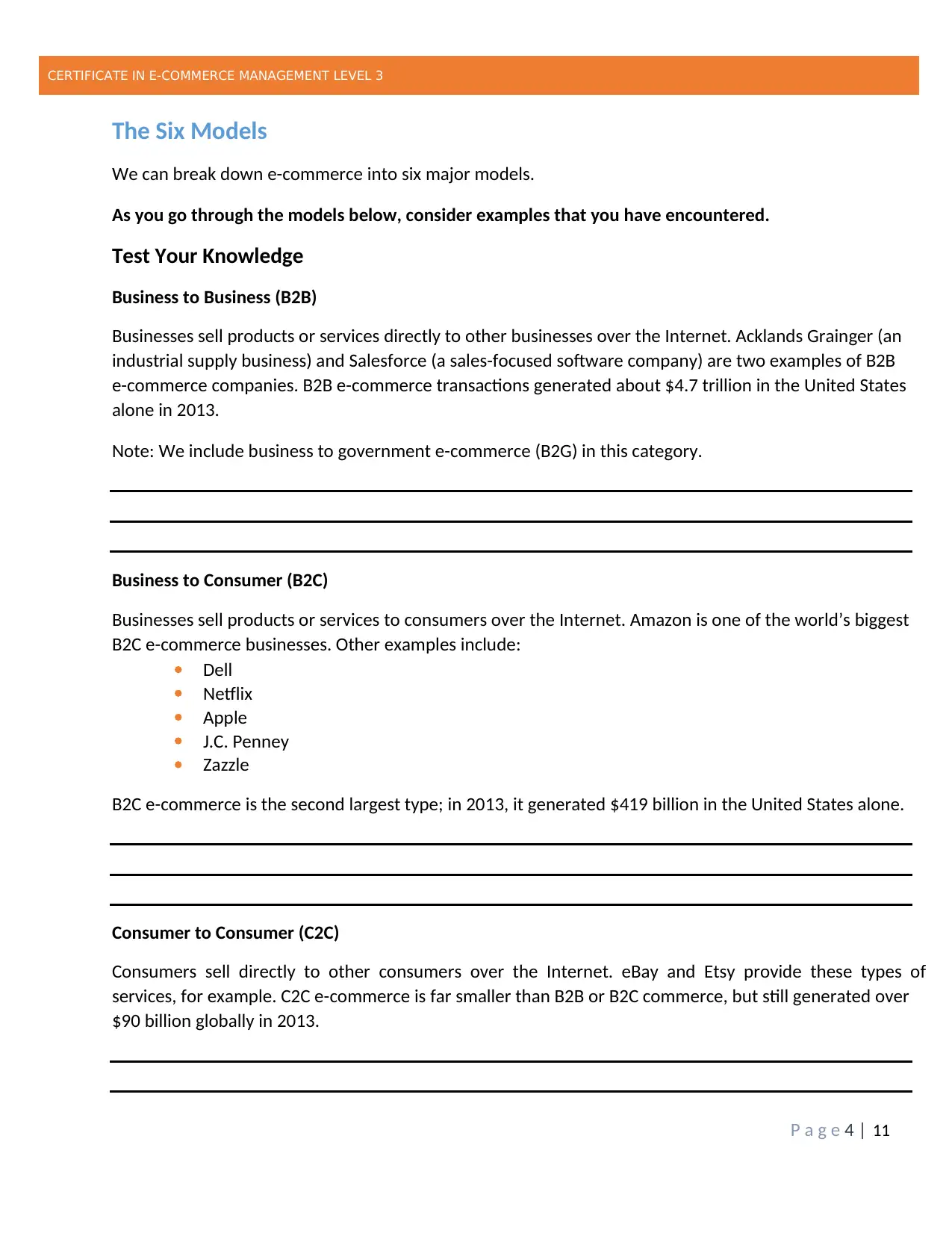
CERTIFICATE IN E-COMMERCE MANAGEMENT LEVEL 3
P a g e 4 | 11
The Six Models
We can break down e-commerce into six major models.
As you go through the models below, consider examples that you have encountered.
Test Your Knowledge
Business to Business (B2B)
Businesses sell products or services directly to other businesses over the Internet. Acklands Grainger (an
industrial supply business) and Salesforce (a sales-focused software company) are two examples of B2B
e-commerce companies. B2B e-commerce transactions generated about $4.7 trillion in the United States
alone in 2013.
Note: We include business to government e-commerce (B2G) in this category.
Business to Consumer (B2C)
Businesses sell products or services to consumers over the Internet. Amazon is one of the world’s biggest
B2C e-commerce businesses. Other examples include:
Dell
Netflix
Apple
J.C. Penney
Zazzle
B2C e-commerce is the second largest type; in 2013, it generated $419 billion in the United States alone.
Consumer to Consumer (C2C)
Consumers sell directly to other consumers over the Internet. eBay and Etsy provide these types of
services, for example. C2C e-commerce is far smaller than B2B or B2C commerce, but still generated over
$90 billion globally in 2013.
P a g e 4 | 11
The Six Models
We can break down e-commerce into six major models.
As you go through the models below, consider examples that you have encountered.
Test Your Knowledge
Business to Business (B2B)
Businesses sell products or services directly to other businesses over the Internet. Acklands Grainger (an
industrial supply business) and Salesforce (a sales-focused software company) are two examples of B2B
e-commerce companies. B2B e-commerce transactions generated about $4.7 trillion in the United States
alone in 2013.
Note: We include business to government e-commerce (B2G) in this category.
Business to Consumer (B2C)
Businesses sell products or services to consumers over the Internet. Amazon is one of the world’s biggest
B2C e-commerce businesses. Other examples include:
Dell
Netflix
Apple
J.C. Penney
Zazzle
B2C e-commerce is the second largest type; in 2013, it generated $419 billion in the United States alone.
Consumer to Consumer (C2C)
Consumers sell directly to other consumers over the Internet. eBay and Etsy provide these types of
services, for example. C2C e-commerce is far smaller than B2B or B2C commerce, but still generated over
$90 billion globally in 2013.
Paraphrase This Document
Need a fresh take? Get an instant paraphrase of this document with our AI Paraphraser
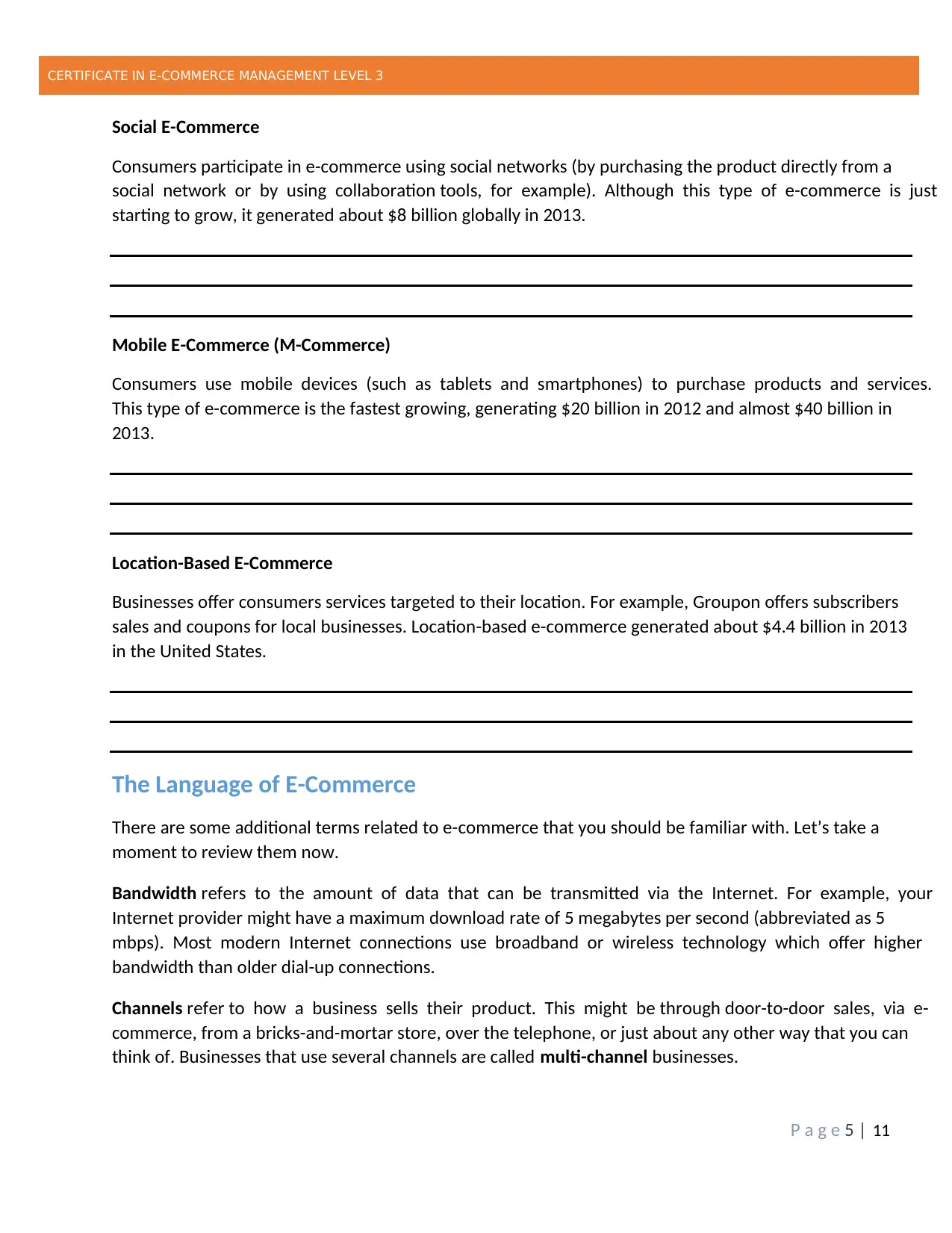
CERTIFICATE IN E-COMMERCE MANAGEMENT LEVEL 3
P a g e 5 | 11
Social E-Commerce
Consumers participate in e-commerce using social networks (by purchasing the product directly from a
social network or by using collaboration tools, for example). Although this type of e-commerce is just
starting to grow, it generated about $8 billion globally in 2013.
Mobile E-Commerce (M-Commerce)
Consumers use mobile devices (such as tablets and smartphones) to purchase products and services.
This type of e-commerce is the fastest growing, generating $20 billion in 2012 and almost $40 billion in
2013.
Location-Based E-Commerce
Businesses offer consumers services targeted to their location. For example, Groupon offers subscribers
sales and coupons for local businesses. Location-based e-commerce generated about $4.4 billion in 2013
in the United States.
The Language of E-Commerce
There are some additional terms related to e-commerce that you should be familiar with. Let’s take a
moment to review them now.
Bandwidth refers to the amount of data that can be transmitted via the Internet. For example, your
Internet provider might have a maximum download rate of 5 megabytes per second (abbreviated as 5
mbps). Most modern Internet connections use broadband or wireless technology which offer higher
bandwidth than older dial-up connections.
Channels refer to how a business sells their product. This might be through door-to-door sales, via e-
commerce, from a bricks-and-mortar store, over the telephone, or just about any other way that you can
think of. Businesses that use several channels are called multi-channel businesses.
P a g e 5 | 11
Social E-Commerce
Consumers participate in e-commerce using social networks (by purchasing the product directly from a
social network or by using collaboration tools, for example). Although this type of e-commerce is just
starting to grow, it generated about $8 billion globally in 2013.
Mobile E-Commerce (M-Commerce)
Consumers use mobile devices (such as tablets and smartphones) to purchase products and services.
This type of e-commerce is the fastest growing, generating $20 billion in 2012 and almost $40 billion in
2013.
Location-Based E-Commerce
Businesses offer consumers services targeted to their location. For example, Groupon offers subscribers
sales and coupons for local businesses. Location-based e-commerce generated about $4.4 billion in 2013
in the United States.
The Language of E-Commerce
There are some additional terms related to e-commerce that you should be familiar with. Let’s take a
moment to review them now.
Bandwidth refers to the amount of data that can be transmitted via the Internet. For example, your
Internet provider might have a maximum download rate of 5 megabytes per second (abbreviated as 5
mbps). Most modern Internet connections use broadband or wireless technology which offer higher
bandwidth than older dial-up connections.
Channels refer to how a business sells their product. This might be through door-to-door sales, via e-
commerce, from a bricks-and-mortar store, over the telephone, or just about any other way that you can
think of. Businesses that use several channels are called multi-channel businesses.
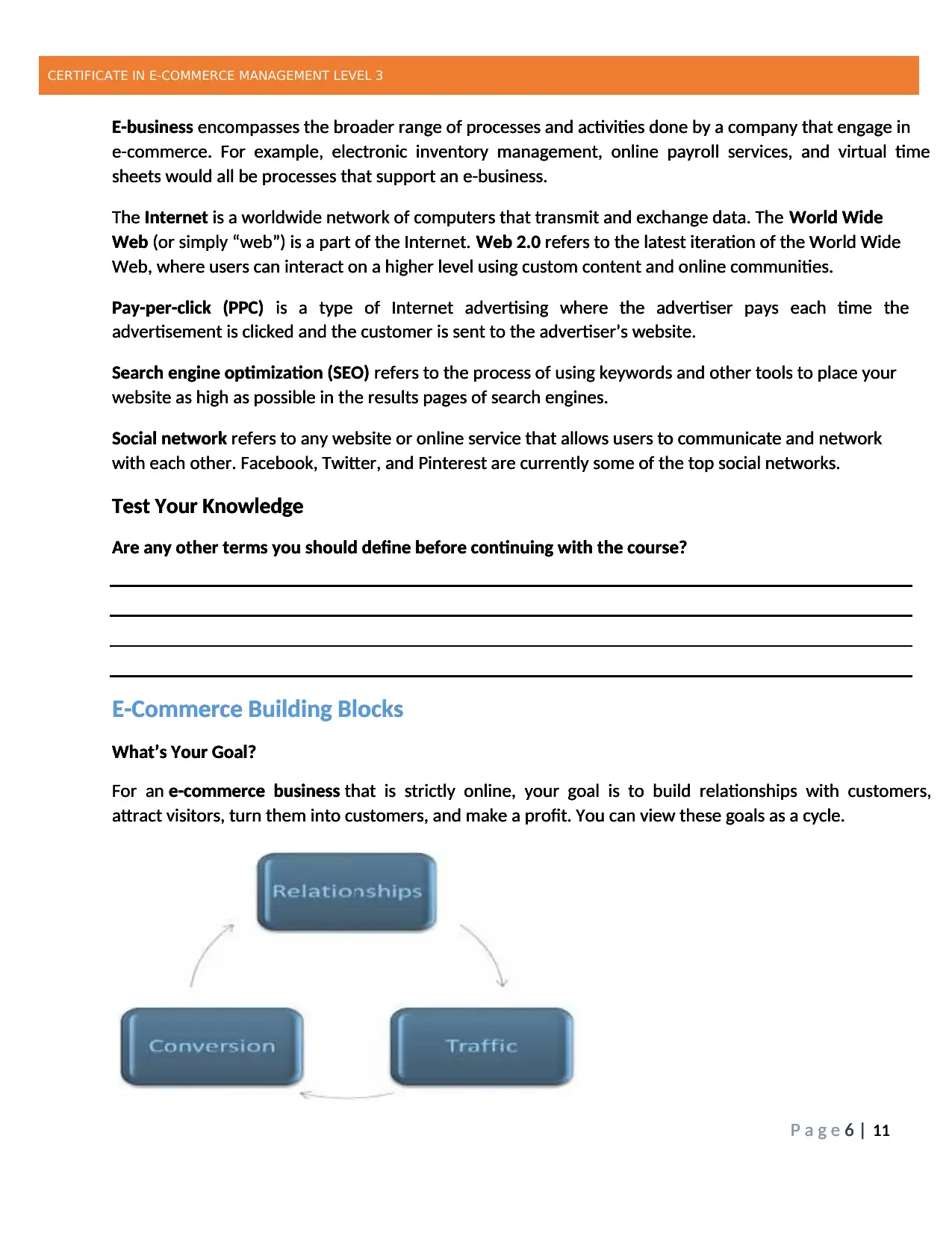
CERTIFICATE IN E-COMMERCE MANAGEMENT LEVEL 3
P a g e 6 | 11
E-business encompasses the broader range of processes and activities done by a company that engage in
e-commerce. For example, electronic inventory management, online payroll services, and virtual time
sheets would all be processes that support an e-business.
The Internet is a worldwide network of computers that transmit and exchange data. The World Wide
Web (or simply “web”) is a part of the Internet. Web 2.0 refers to the latest iteration of the World Wide
Web, where users can interact on a higher level using custom content and online communities.
Pay-per-click (PPC) is a type of Internet advertising where the advertiser pays each time the
advertisement is clicked and the customer is sent to the advertiser’s website.
Search engine optimization (SEO) refers to the process of using keywords and other tools to place your
website as high as possible in the results pages of search engines.
Social network refers to any website or online service that allows users to communicate and network
with each other. Facebook, Twitter, and Pinterest are currently some of the top social networks.
Test Your Knowledge
Are any other terms you should define before continuing with the course?
E-Commerce Building Blocks
What’s Your Goal?
For an e-commerce business that is strictly online, your goal is to build relationships with customers,
attract visitors, turn them into customers, and make a profit. You can view these goals as a cycle.
CERTIFICATE IN E-COMMERCE MANAGEMENT LEVEL 3
P a g e 6 | 11
E-business encompasses the broader range of processes and activities done by a company that engage in
e-commerce. For example, electronic inventory management, online payroll services, and virtual time
sheets would all be processes that support an e-business.
The Internet is a worldwide network of computers that transmit and exchange data. The World Wide
Web (or simply “web”) is a part of the Internet. Web 2.0 refers to the latest iteration of the World Wide
Web, where users can interact on a higher level using custom content and online communities.
Pay-per-click (PPC) is a type of Internet advertising where the advertiser pays each time the
advertisement is clicked and the customer is sent to the advertiser’s website.
Search engine optimization (SEO) refers to the process of using keywords and other tools to place your
website as high as possible in the results pages of search engines.
Social network refers to any website or online service that allows users to communicate and network
with each other. Facebook, Twitter, and Pinterest are currently some of the top social networks.
Test Your Knowledge
Are any other terms you should define before continuing with the course?
E-Commerce Building Blocks
What’s Your Goal?
For an e-commerce business that is strictly online, your goal is to build relationships with customers,
attract visitors, turn them into customers, and make a profit. You can view these goals as a cycle.
CERTIFICATE IN E-COMMERCE MANAGEMENT LEVEL 3
P a g e 6 | 11
E-business encompasses the broader range of processes and activities done by a company that engage in
e-commerce. For example, electronic inventory management, online payroll services, and virtual time
sheets would all be processes that support an e-business.
The Internet is a worldwide network of computers that transmit and exchange data. The World Wide
Web (or simply “web”) is a part of the Internet. Web 2.0 refers to the latest iteration of the World Wide
Web, where users can interact on a higher level using custom content and online communities.
Pay-per-click (PPC) is a type of Internet advertising where the advertiser pays each time the
advertisement is clicked and the customer is sent to the advertiser’s website.
Search engine optimization (SEO) refers to the process of using keywords and other tools to place your
website as high as possible in the results pages of search engines.
Social network refers to any website or online service that allows users to communicate and network
with each other. Facebook, Twitter, and Pinterest are currently some of the top social networks.
Test Your Knowledge
Are any other terms you should define before continuing with the course?
E-Commerce Building Blocks
What’s Your Goal?
For an e-commerce business that is strictly online, your goal is to build relationships with customers,
attract visitors, turn them into customers, and make a profit. You can view these goals as a cycle.
P a g e 6 | 11
E-business encompasses the broader range of processes and activities done by a company that engage in
e-commerce. For example, electronic inventory management, online payroll services, and virtual time
sheets would all be processes that support an e-business.
The Internet is a worldwide network of computers that transmit and exchange data. The World Wide
Web (or simply “web”) is a part of the Internet. Web 2.0 refers to the latest iteration of the World Wide
Web, where users can interact on a higher level using custom content and online communities.
Pay-per-click (PPC) is a type of Internet advertising where the advertiser pays each time the
advertisement is clicked and the customer is sent to the advertiser’s website.
Search engine optimization (SEO) refers to the process of using keywords and other tools to place your
website as high as possible in the results pages of search engines.
Social network refers to any website or online service that allows users to communicate and network
with each other. Facebook, Twitter, and Pinterest are currently some of the top social networks.
Test Your Knowledge
Are any other terms you should define before continuing with the course?
E-Commerce Building Blocks
What’s Your Goal?
For an e-commerce business that is strictly online, your goal is to build relationships with customers,
attract visitors, turn them into customers, and make a profit. You can view these goals as a cycle.
CERTIFICATE IN E-COMMERCE MANAGEMENT LEVEL 3
P a g e 6 | 11
E-business encompasses the broader range of processes and activities done by a company that engage in
e-commerce. For example, electronic inventory management, online payroll services, and virtual time
sheets would all be processes that support an e-business.
The Internet is a worldwide network of computers that transmit and exchange data. The World Wide
Web (or simply “web”) is a part of the Internet. Web 2.0 refers to the latest iteration of the World Wide
Web, where users can interact on a higher level using custom content and online communities.
Pay-per-click (PPC) is a type of Internet advertising where the advertiser pays each time the
advertisement is clicked and the customer is sent to the advertiser’s website.
Search engine optimization (SEO) refers to the process of using keywords and other tools to place your
website as high as possible in the results pages of search engines.
Social network refers to any website or online service that allows users to communicate and network
with each other. Facebook, Twitter, and Pinterest are currently some of the top social networks.
Test Your Knowledge
Are any other terms you should define before continuing with the course?
E-Commerce Building Blocks
What’s Your Goal?
For an e-commerce business that is strictly online, your goal is to build relationships with customers,
attract visitors, turn them into customers, and make a profit. You can view these goals as a cycle.
CERTIFICATE IN E-COMMERCE MANAGEMENT LEVEL 3
P a g e 6 | 11
E-business encompasses the broader range of processes and activities done by a company that engage in
e-commerce. For example, electronic inventory management, online payroll services, and virtual time
sheets would all be processes that support an e-business.
The Internet is a worldwide network of computers that transmit and exchange data. The World Wide
Web (or simply “web”) is a part of the Internet. Web 2.0 refers to the latest iteration of the World Wide
Web, where users can interact on a higher level using custom content and online communities.
Pay-per-click (PPC) is a type of Internet advertising where the advertiser pays each time the
advertisement is clicked and the customer is sent to the advertiser’s website.
Search engine optimization (SEO) refers to the process of using keywords and other tools to place your
website as high as possible in the results pages of search engines.
Social network refers to any website or online service that allows users to communicate and network
with each other. Facebook, Twitter, and Pinterest are currently some of the top social networks.
Test Your Knowledge
Are any other terms you should define before continuing with the course?
E-Commerce Building Blocks
What’s Your Goal?
For an e-commerce business that is strictly online, your goal is to build relationships with customers,
attract visitors, turn them into customers, and make a profit. You can view these goals as a cycle.
⊘ This is a preview!⊘
Do you want full access?
Subscribe today to unlock all pages.

Trusted by 1+ million students worldwide
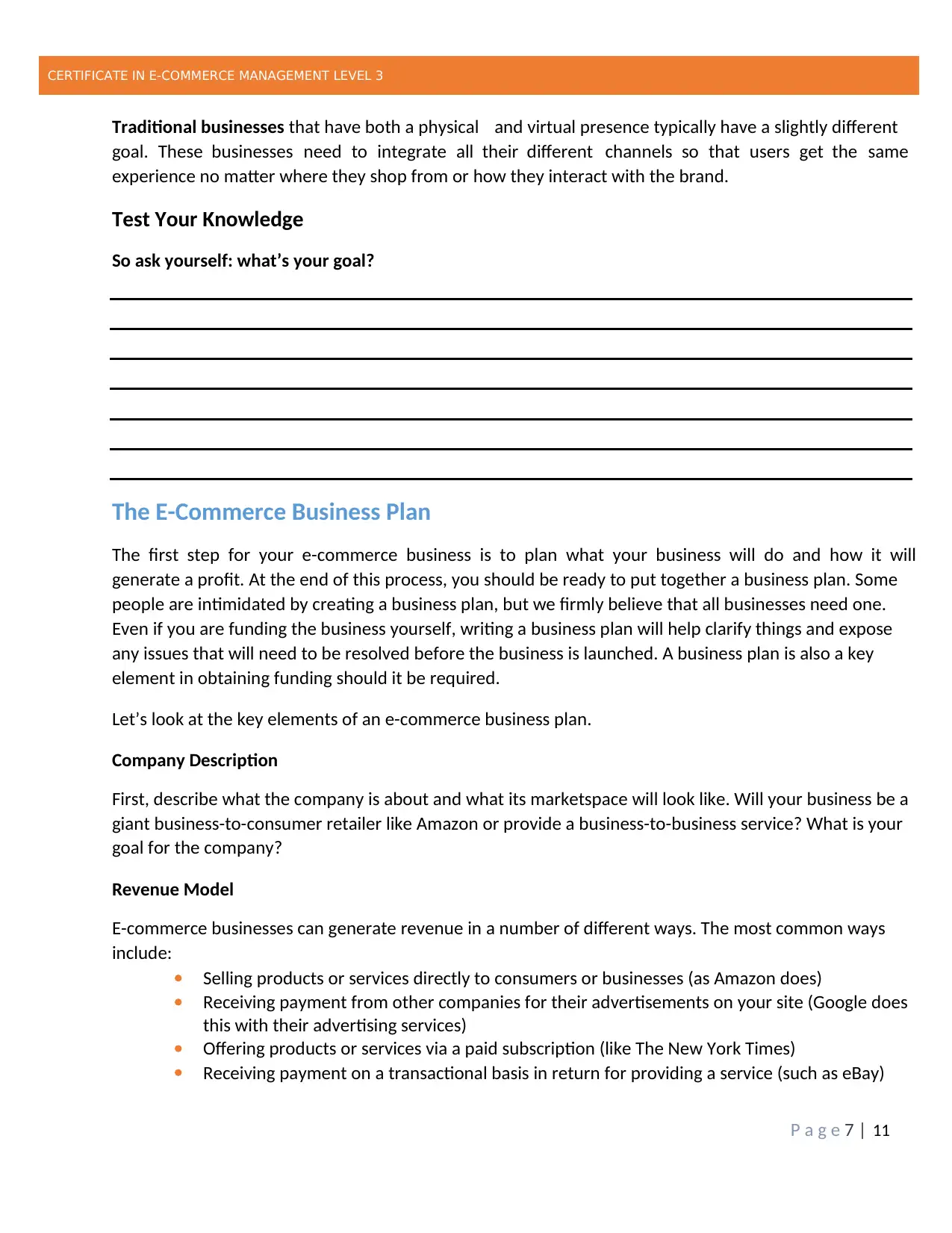
CERTIFICATE IN E-COMMERCE MANAGEMENT LEVEL 3
P a g e 7 | 11
Traditional businesses that have both a physical and virtual presence typically have a slightly different
goal. These businesses need to integrate all their different channels so that users get the same
experience no matter where they shop from or how they interact with the brand.
Test Your Knowledge
So ask yourself: what’s your goal?
The E-Commerce Business Plan
The first step for your e-commerce business is to plan what your business will do and how it will
generate a profit. At the end of this process, you should be ready to put together a business plan. Some
people are intimidated by creating a business plan, but we firmly believe that all businesses need one.
Even if you are funding the business yourself, writing a business plan will help clarify things and expose
any issues that will need to be resolved before the business is launched. A business plan is also a key
element in obtaining funding should it be required.
Let’s look at the key elements of an e-commerce business plan.
Company Description
First, describe what the company is about and what its marketspace will look like. Will your business be a
giant business-to-consumer retailer like Amazon or provide a business-to-business service? What is your
goal for the company?
Revenue Model
E-commerce businesses can generate revenue in a number of different ways. The most common ways
include:
Selling products or services directly to consumers or businesses (as Amazon does)
Receiving payment from other companies for their advertisements on your site (Google does
this with their advertising services)
Offering products or services via a paid subscription (like The New York Times)
Receiving payment on a transactional basis in return for providing a service (such as eBay)
P a g e 7 | 11
Traditional businesses that have both a physical and virtual presence typically have a slightly different
goal. These businesses need to integrate all their different channels so that users get the same
experience no matter where they shop from or how they interact with the brand.
Test Your Knowledge
So ask yourself: what’s your goal?
The E-Commerce Business Plan
The first step for your e-commerce business is to plan what your business will do and how it will
generate a profit. At the end of this process, you should be ready to put together a business plan. Some
people are intimidated by creating a business plan, but we firmly believe that all businesses need one.
Even if you are funding the business yourself, writing a business plan will help clarify things and expose
any issues that will need to be resolved before the business is launched. A business plan is also a key
element in obtaining funding should it be required.
Let’s look at the key elements of an e-commerce business plan.
Company Description
First, describe what the company is about and what its marketspace will look like. Will your business be a
giant business-to-consumer retailer like Amazon or provide a business-to-business service? What is your
goal for the company?
Revenue Model
E-commerce businesses can generate revenue in a number of different ways. The most common ways
include:
Selling products or services directly to consumers or businesses (as Amazon does)
Receiving payment from other companies for their advertisements on your site (Google does
this with their advertising services)
Offering products or services via a paid subscription (like The New York Times)
Receiving payment on a transactional basis in return for providing a service (such as eBay)
Paraphrase This Document
Need a fresh take? Get an instant paraphrase of this document with our AI Paraphraser
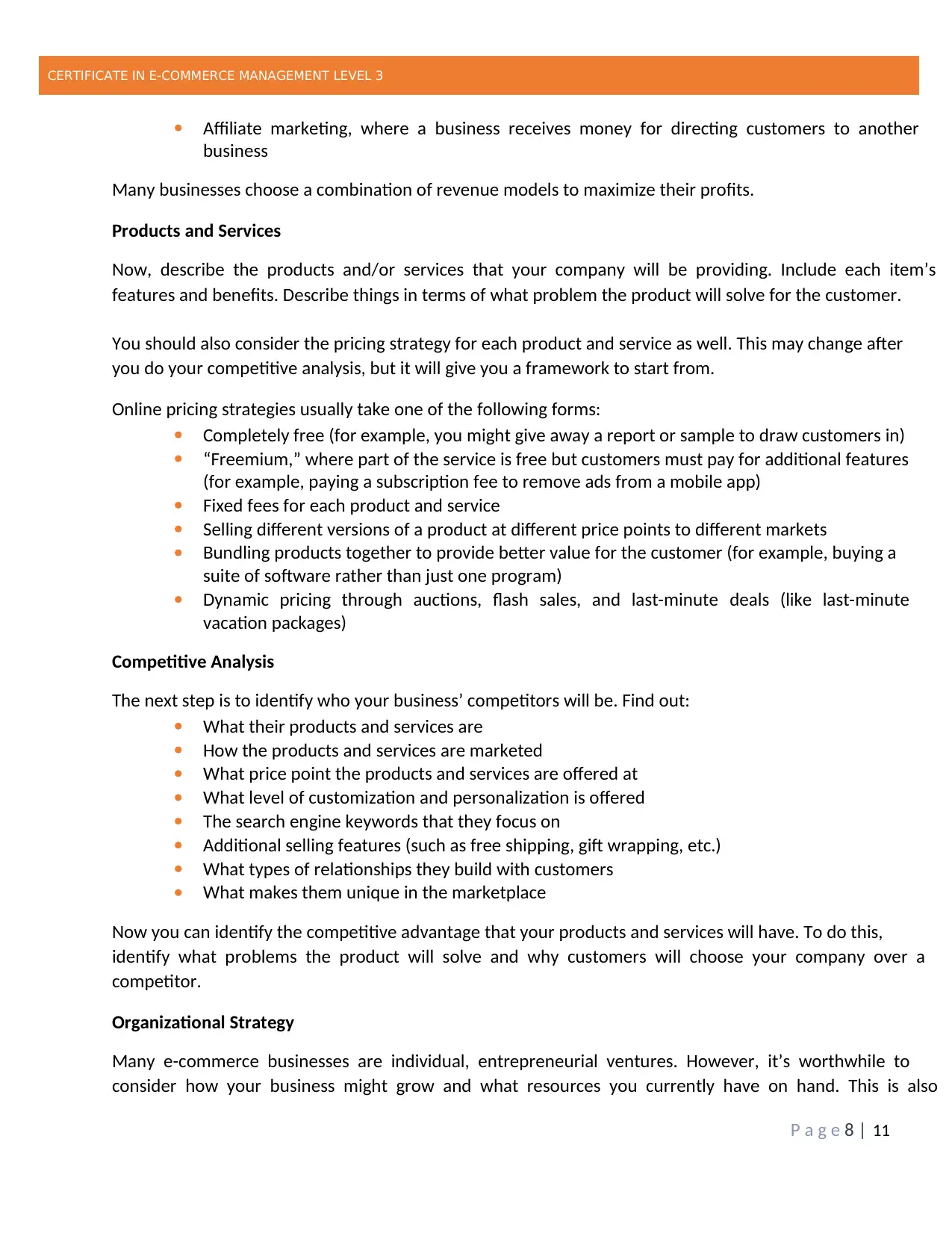
CERTIFICATE IN E-COMMERCE MANAGEMENT LEVEL 3
P a g e 8 | 11
Affiliate marketing, where a business receives money for directing customers to another
business
Many businesses choose a combination of revenue models to maximize their profits.
Products and Services
Now, describe the products and/or services that your company will be providing. Include each item’s
features and benefits. Describe things in terms of what problem the product will solve for the customer.
You should also consider the pricing strategy for each product and service as well. This may change after
you do your competitive analysis, but it will give you a framework to start from.
Online pricing strategies usually take one of the following forms:
Completely free (for example, you might give away a report or sample to draw customers in)
“Freemium,” where part of the service is free but customers must pay for additional features
(for example, paying a subscription fee to remove ads from a mobile app)
Fixed fees for each product and service
Selling different versions of a product at different price points to different markets
Bundling products together to provide better value for the customer (for example, buying a
suite of software rather than just one program)
Dynamic pricing through auctions, flash sales, and last-minute deals (like last-minute
vacation packages)
Competitive Analysis
The next step is to identify who your business’ competitors will be. Find out:
What their products and services are
How the products and services are marketed
What price point the products and services are offered at
What level of customization and personalization is offered
The search engine keywords that they focus on
Additional selling features (such as free shipping, gift wrapping, etc.)
What types of relationships they build with customers
What makes them unique in the marketplace
Now you can identify the competitive advantage that your products and services will have. To do this,
identify what problems the product will solve and why customers will choose your company over a
competitor.
Organizational Strategy
Many e-commerce businesses are individual, entrepreneurial ventures. However, it’s worthwhile to
consider how your business might grow and what resources you currently have on hand. This is also
P a g e 8 | 11
Affiliate marketing, where a business receives money for directing customers to another
business
Many businesses choose a combination of revenue models to maximize their profits.
Products and Services
Now, describe the products and/or services that your company will be providing. Include each item’s
features and benefits. Describe things in terms of what problem the product will solve for the customer.
You should also consider the pricing strategy for each product and service as well. This may change after
you do your competitive analysis, but it will give you a framework to start from.
Online pricing strategies usually take one of the following forms:
Completely free (for example, you might give away a report or sample to draw customers in)
“Freemium,” where part of the service is free but customers must pay for additional features
(for example, paying a subscription fee to remove ads from a mobile app)
Fixed fees for each product and service
Selling different versions of a product at different price points to different markets
Bundling products together to provide better value for the customer (for example, buying a
suite of software rather than just one program)
Dynamic pricing through auctions, flash sales, and last-minute deals (like last-minute
vacation packages)
Competitive Analysis
The next step is to identify who your business’ competitors will be. Find out:
What their products and services are
How the products and services are marketed
What price point the products and services are offered at
What level of customization and personalization is offered
The search engine keywords that they focus on
Additional selling features (such as free shipping, gift wrapping, etc.)
What types of relationships they build with customers
What makes them unique in the marketplace
Now you can identify the competitive advantage that your products and services will have. To do this,
identify what problems the product will solve and why customers will choose your company over a
competitor.
Organizational Strategy
Many e-commerce businesses are individual, entrepreneurial ventures. However, it’s worthwhile to
consider how your business might grow and what resources you currently have on hand. This is also
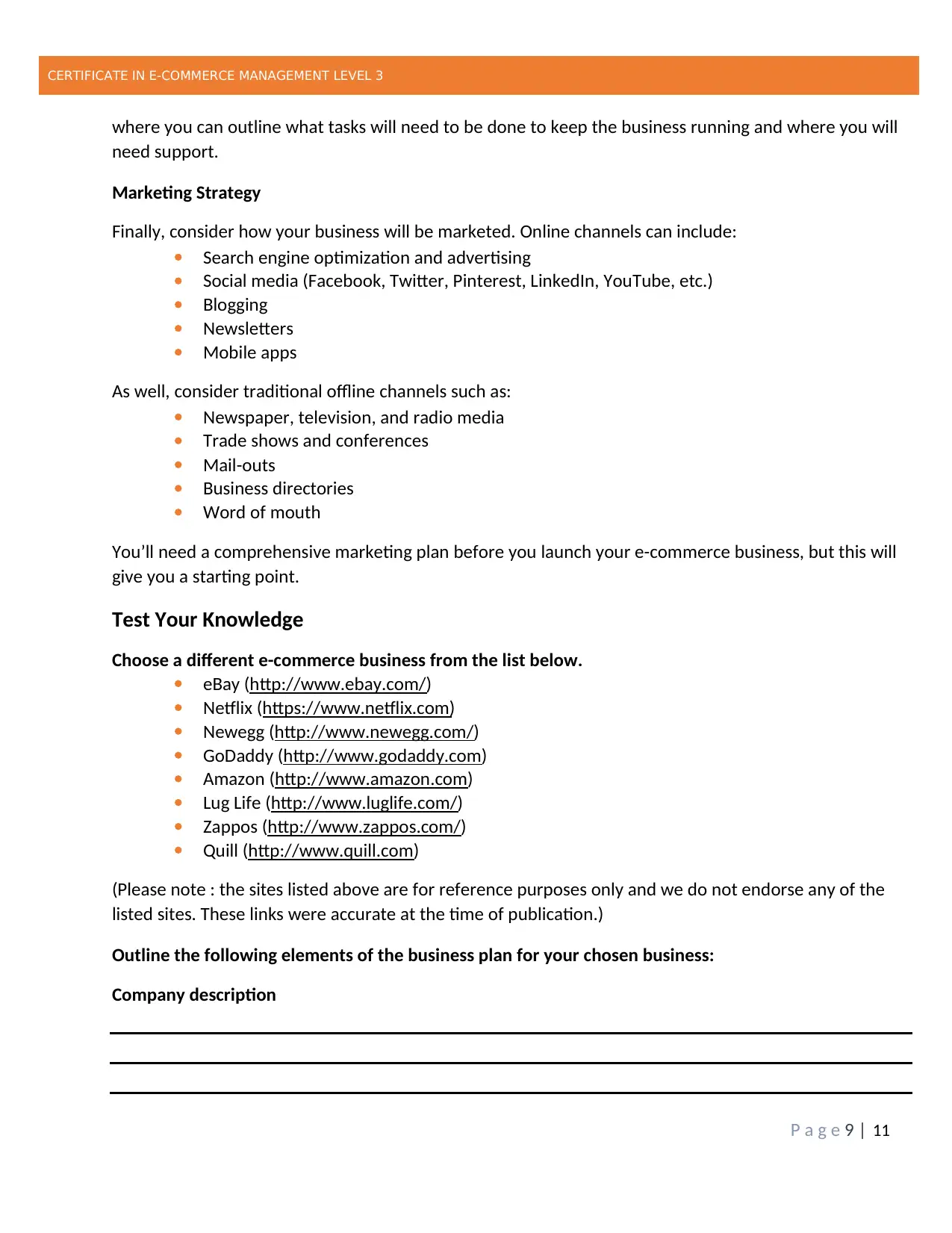
CERTIFICATE IN E-COMMERCE MANAGEMENT LEVEL 3
P a g e 9 | 11
where you can outline what tasks will need to be done to keep the business running and where you will
need support.
Marketing Strategy
Finally, consider how your business will be marketed. Online channels can include:
Search engine optimization and advertising
Social media (Facebook, Twitter, Pinterest, LinkedIn, YouTube, etc.)
Blogging
Newsletters
Mobile apps
As well, consider traditional offline channels such as:
Newspaper, television, and radio media
Trade shows and conferences
Mail-outs
Business directories
Word of mouth
You’ll need a comprehensive marketing plan before you launch your e-commerce business, but this will
give you a starting point.
Test Your Knowledge
Choose a different e-commerce business from the list below.
eBay (http://www.ebay.com/)
Netflix (https://www.netflix.com)
Newegg (http://www.newegg.com/)
GoDaddy (http://www.godaddy.com)
Amazon (http://www.amazon.com)
Lug Life (http://www.luglife.com/)
Zappos (http://www.zappos.com/)
Quill (http://www.quill.com)
(Please note : the sites listed above are for reference purposes only and we do not endorse any of the
listed sites. These links were accurate at the time of publication.)
Outline the following elements of the business plan for your chosen business:
Company description
P a g e 9 | 11
where you can outline what tasks will need to be done to keep the business running and where you will
need support.
Marketing Strategy
Finally, consider how your business will be marketed. Online channels can include:
Search engine optimization and advertising
Social media (Facebook, Twitter, Pinterest, LinkedIn, YouTube, etc.)
Blogging
Newsletters
Mobile apps
As well, consider traditional offline channels such as:
Newspaper, television, and radio media
Trade shows and conferences
Mail-outs
Business directories
Word of mouth
You’ll need a comprehensive marketing plan before you launch your e-commerce business, but this will
give you a starting point.
Test Your Knowledge
Choose a different e-commerce business from the list below.
eBay (http://www.ebay.com/)
Netflix (https://www.netflix.com)
Newegg (http://www.newegg.com/)
GoDaddy (http://www.godaddy.com)
Amazon (http://www.amazon.com)
Lug Life (http://www.luglife.com/)
Zappos (http://www.zappos.com/)
Quill (http://www.quill.com)
(Please note : the sites listed above are for reference purposes only and we do not endorse any of the
listed sites. These links were accurate at the time of publication.)
Outline the following elements of the business plan for your chosen business:
Company description
⊘ This is a preview!⊘
Do you want full access?
Subscribe today to unlock all pages.

Trusted by 1+ million students worldwide
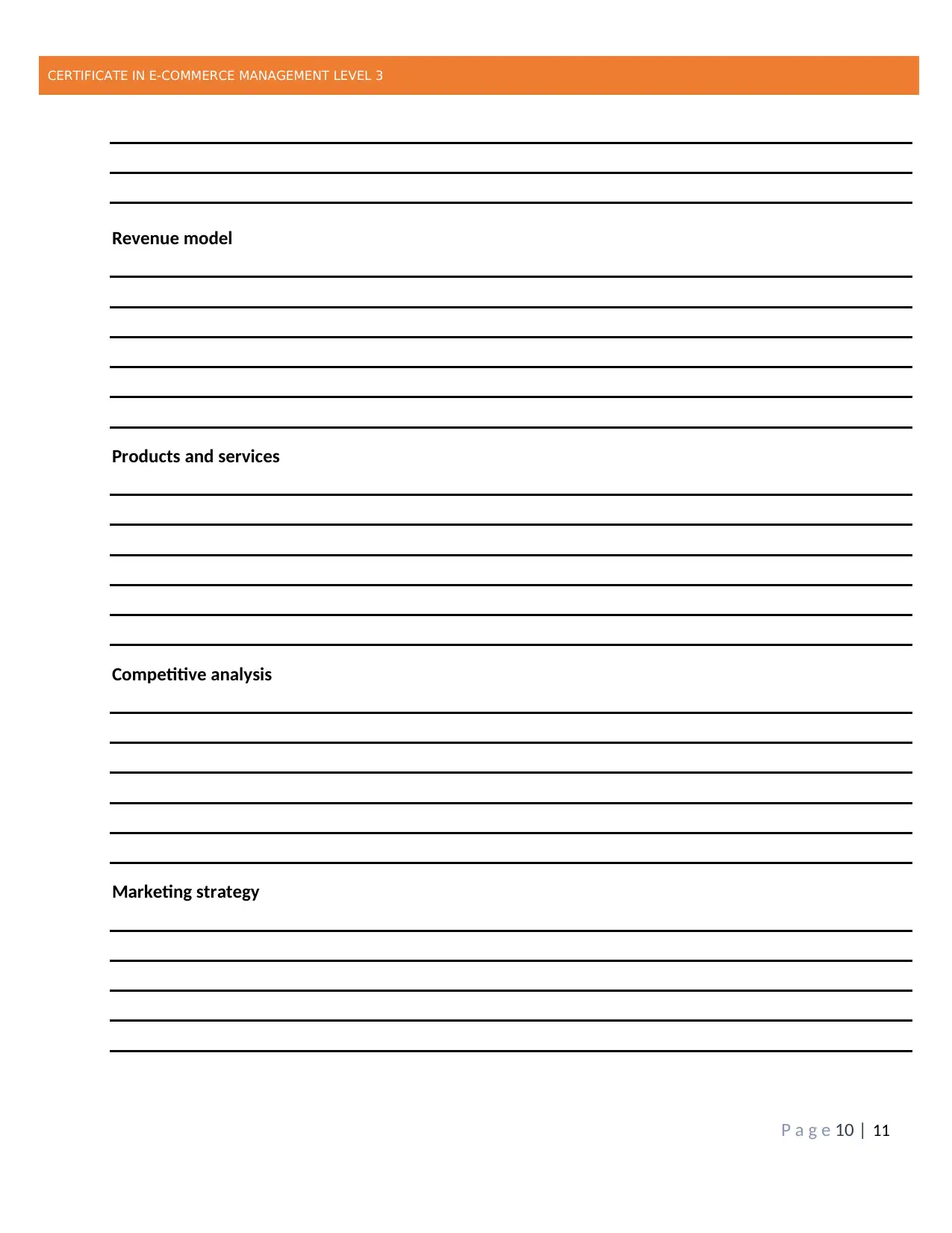
CERTIFICATE IN E-COMMERCE MANAGEMENT LEVEL 3
P a g e 10 | 11
Revenue model
Products and services
Competitive analysis
Marketing strategy
P a g e 10 | 11
Revenue model
Products and services
Competitive analysis
Marketing strategy
Paraphrase This Document
Need a fresh take? Get an instant paraphrase of this document with our AI Paraphraser

CERTIFICATE IN E-COMMERCE MANAGEMENT LEVEL 3
P a g e 11 | 11
P a g e 11 | 11
1 out of 11
Related Documents
Your All-in-One AI-Powered Toolkit for Academic Success.
+13062052269
info@desklib.com
Available 24*7 on WhatsApp / Email
![[object Object]](/_next/static/media/star-bottom.7253800d.svg)
Unlock your academic potential
Copyright © 2020–2025 A2Z Services. All Rights Reserved. Developed and managed by ZUCOL.




